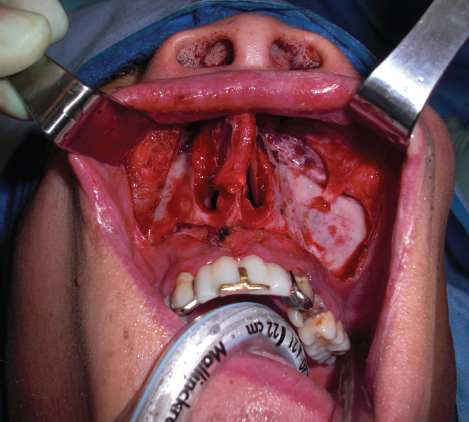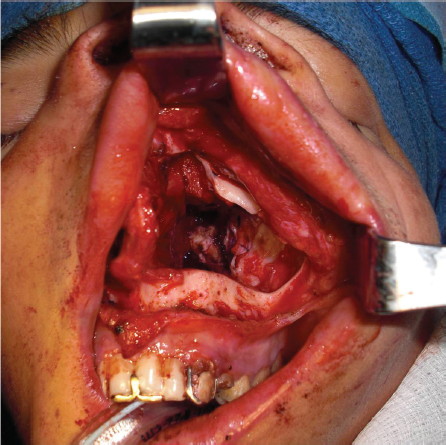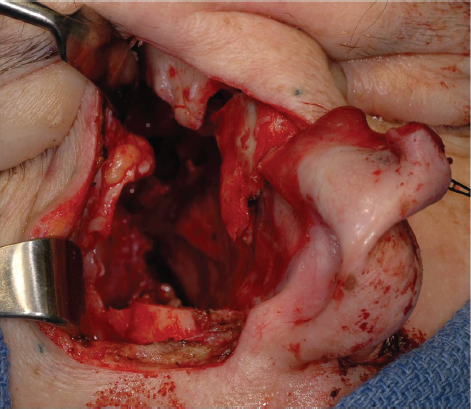32 Open Approaches to the Sinuses and Anterior Skull Base The adaptation of endoscopic techniques for the treatment of sinonasal and anterior skull base pathology has resulted in a significant change in the management of patients in recent years.1 However, open approaches to the sinuses and skull base have withstood the test of time and are integral to the comprehensive care of patients with sinonasal pathology. The appropriate selection of an open technique provides the surgeon wide exposure and direct visualization of all aspects of the paranasal sinuses and anterior skull base. This allows identification of the complete extent of tumor before tumor manipulation and enables the surgeon to perform an en bloc resection. These approaches also permit an unrestricted access for reconstructive procedures after tumor extirpation is complete. This chapter will address transfacial and intracranial approaches to the sinonasal region with special attention to the craniofacial resection for the treatment of malignant tumors of the anterior skull base. Caldwell and Luc described the anterior antrostomy separately in the late 1800s. This approach allows access to the entire maxillary sinus, orbital floor, and pterygomaxillary fossa. A sublabial incision is performed leaving enough of a cuff of gingival mucosa to allow later reapproximation. The periosteum is elevated from the front face of the maxilla preserving the infraorbital nerve. After the elevation of periosteum from the medial buttress to the lateral buttress and superiorly to the infraorbital rim, the thin anterior wall of the maxillary sinus is entered sharply at the canine fossa with an osteotome or drill. A rongeur is then used to remove the remainder of the anterior wall of the sinus or as much bone as required to achieve the desired exposure. The Caldwell-Luc approach for chronic sinusitis has largely been replaced by endoscopic techniques but can still be a useful procedure when endoscopic methods fail.2–4 Endoscopic sinus surgery has also become the preferred approach for biopsy of maxillary sinus tumors, approaches to the orbital floor, removal of polyps, and approaches to the pterygopalatine fossa because it is associated with decreased morbidity compared with the Caldwell-Luc approach.5 Despite this, the Caldwell-Luc approach remains useful in certain instances for orbital decompression, removal of benign tumors isolated to the maxillary sinus, foreign body removal, and management of facial trauma and is a tool that should remain in the repertoire of the head and neck surgeon.6–8 The midfacial degloving approach was described for the removal of tumors from the nasal cavity, paranasal sinuses, nasal septum, and nasopharynx in 1979.9 The operative technique was originally described in 1974.10 Bilateral intercartilaginous incisions are performed and extended to a transfixion incision posterior to the medial crura. The upper and lower lateral cartilages are separated and the nasal envelope is elevated off the upper lateral cartilages through the intercartilaginous incisions. The intranasal incision is extended circumferentially around the piriform aperture and nasal floor effectively separating the nasal tip and bilateral lower lateral cartilage from the nasal septum, nasal dorsum, and piriform aperture. Bilateral sublabial incisions are connected across the midline, and the periosteum is elevated to the inferior orbital rim with care taken to preserve the infraorbital nerves (Fig. 32.1). A medial maxillectomy is performed by making bone cuts through the medial buttress superiorly and inferiorly, and then removing the lateral nasal wall with the attached inferior turbinate. The anterior and posterior walls of the maxillary sinus can also be resected if indicated. This provides access to the nasal septum, maxillary sinus, pterygopalatine fossa, infratemporal fossa, and nasopharynx (Fig. 32.2). Exposure to the superior ethmoid sinuses and the frontal sinus as well as the anterior skull base is limited with this approach. After tumor removal, the medial buttress can be plated back into position as a free bone graft. Careful attention should be directed to closure of the circumferential intranasal incisions to prevent vestibular stenosis. Figure 32.1 Midfacial degloving approach. Sublabial and intranasal incisions allow elevation of the nasal envelope and lower lateral cartilages. The left maxilla has been exposed to the infraorbital rim for medial maxillectomy. Note preservation of the infraorbital nerve on the left. An obvious advantage of this approach is the avoidance of a visible scar. Complications include nasal crusting, vestibular stenosis, and transient hypesthesia in the distribution of the infraorbital nerve.11 Modifications of the procedure have been described to decrease the incidence of vestibular stenosis, limit intranasal incisions, or avoid exposure of the contralateral midface.12–16 The midfacial degloving approach can be combined with Le Fort I osteotomies to improve access to the nasopharynx and clivus.17 Indications for the midfacial degloving approach include treatment of midfacial trauma, treatment of large septal perforations, resection of benign and malignant tumors of the nasal septum, nasal sidewall, maxillary sinus, and nasopharynx.18,19 It is ideally suited for large or benign but locally aggressive tumors that are not amenable to resection with endoscopic techniques such as dentigerous cysts, inverted papilloma, or larger juvenile (neuro) angiofibromas as it provides a wide exposure without the need for facial incisions.11 It can be used in conjunction with intracranial approaches for large anterior skull base malignancies with invasion of the palate, clivus, or cavernous sinus.20 Tumors that involve the anterior skull base, medial orbital wall, and ethmoid sinuses are not ideally suited to resection via a midfacial degloving approach alone because exposure and visualization of these areas is limited.11 Moure of Bordeaux presented the lateral rhinotomy technique in 1902. Classically, this approach involves a skin incision beginning below the brow and medial to the medial canthus, extending inferiorly in the nasofacial groove. The incision is then taken to the alar groove and curves around to the upper lip. The lip can be split by continuing the incision inferiorly along the ipsilateral philtrum,21 but a significant exposure can be attained laterally without splitting the lip. Modifications of the classic incision have been described to improve cosmesis. These include placement of the incision between the dorsal and lateral nasal esthetic units instead of in the nasofacial groove, and adding a “V” to the incision opposite the medial canthus to prevent webbing.22,23 After incising the skin, the dissection continues to the maxilla. The periosteum is elevated from medial to lateral off the maxilla inferiorly and the lamina papyracea superior-laterally. Care is taken to preserve the infraorbital nerve and to leave the skin and periosteum attached to the nasal bone medially. Inferiorly, the nasal cavity is entered along the piriform aperture. To allow access to the superior nasal cavity, low lateral, transverse, and occasionally medial osteotomies are performed. These permit the ipsilateral nasal bone to be elevated with the soft tissue envelope toward the contralateral side (Fig. 32.3). This approach exposes the ipsilateral nasal cavity and nasal septum and allows access to the ipsilateral maxillary, ethmoid, frontal, and sphenoid sinuses. Figure 32.3 Lateral rhinotomy approach. Medial maxillectomy through lateral rhinotomy approach allows access to the nasal septum, maxillary sinus, ethmoid sinuses, sphenoid sinus, nasopharynx, and anterior skull base. Medial maxillectomy is the most common procedure performed through the lateral rhinotomy approach.24 The ethmoid and frontal sinuses can be accessed through the superior aspect of this incision for external ethmoidectomy or frontal sinusotomy. It also provides access to the anterior and posterior ethmoid arteries. As will be discussed in greater detail later, the lateral rhinotomy can be combined with intracranial approaches for unparalleled access to the anterior skull base. Although this approach involves an incision on the face, meticulous closure results in an inconspicuous scar that is well tolerated by patients and is minimally visible to observers.25 The Weber-Ferguson incision is an extension of the classic lateral rhinotomy incision that involves carrying the inferior incision through the upper lip and gingivolabial sulcus and the superior incision laterally, inferior to the eye. The periosteum is elevated from medial to lateral, raising a laterally based skin flap and exposing the entire maxilla. Although this provides access for total or subtotal maxillectomy, these regions can often be reached without the superior incision. If an orbital exenteration is indicated at the time of total maxillectomy, an additional incision can be made superior to the eye. Modifications of the lateral rhinotomy incision that allow for total maxillectomy—without the Weber-Ferguson extension—have also been described. The Weber-Ferguson extension has been shown to result in lower eyelid complications, unsightly scarring, and poor cosmetic outcome.26 For many years, lateral rhinotomy was the approach of choice for the surgical treatment of inverted papilloma.27 Several studies have demonstrated the effectiveness of endoscopic approaches for inverted papilloma, even for large or recurrent tumors.28,29 Endoscopic resection of inverted papilloma has become the favored approach.30–34 Open approaches remain important in selected cases such as those with frontal sinus or supraorbital extension, associated malignancy, or significant scarring.35–37 The lateral rhinotomy approach has been demonstrated to be a safe and effective approach for the treatment of a variety of sinonasal pathology including benign and malignant tumors, epistaxis, and cerebrospinal fluid leaks.38 Goodale described the osteoplastic flap for the treatment of chronic frontal sinus disease in 1958, although the use of the osteoplastic flap to access the frontal sinus was described in 1800s.39,40 The classic approach involves a coronal incision and an inferiorly based bone flap, although this approach can be performed through a mid-forehead or brow incision and a superiorly based bone flap has also been described.41
Transfacial Approaches
Caldwell-Luc
Midfacial Degloving
Lateral Rhinotomy
Intracranial Approaches
Frontal Sinus Osteoplastic Flap
![]()
Stay updated, free articles. Join our Telegram channel

Full access? Get Clinical Tree





